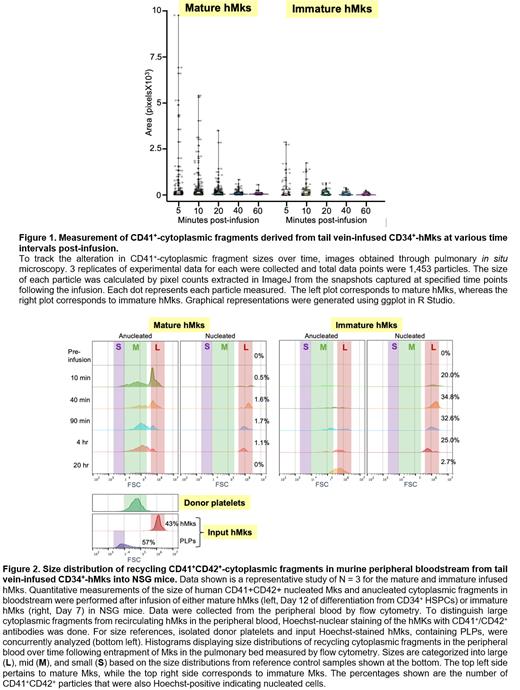Introduction: Thrombopoiesis, the process by which megakaryocytes (Mks) release platelets, is still not well understood, including where it occurs and how a Mk releases its platelet content. The present study, based on infused human Mks (hMks) into immunocompromised mice, and measurements of the subsequent presence of nucleated Mks and anucleated cytoplasmic fragments in the lungs and in the peripheral blood were carried out to provide new insights into this process.
Method: To gain a deeper understanding of the role of the lung in thrombopoiesis, we performed quantitative, temporal measurements of the size of human CD41 +CD42 + nucleated Mks and anucleated cytoplasmic fragments after tail-vein infusion of either mature (Day 12 of culture from CD34 + hematopoietic stem/progenitor cells (HSPCs)) hMks or immature (Day 7 of culture from CD34 + HSPCs) in NOD-scid gamma (NSG) mice. Data was collected from both the pulmonary bed by in situ microscopy ( Figure 1) and in the peripheral blood by flow cytometry ( Figure 2). To distinguish in the peripheral blood large cytoplasmic fragments from recirculating hMks, Hoechst-nuclear staining was done prior to flow cytometric analysis For size references, isolated donor platelets and input Hoechst-stained hMks, containing platelet-like particles (PLPs), were concurrently analyzed ( Figure 2, bottom left).
Results: By pulmonary in situ microscopy, we found that infused mature hMks were entrapped on their first passage through the lungs. Over the subsequent hour, anucleate cytoplasmic fragments ( Figure 1, left) recycle to the lungs becoming increasingly smaller in size over the hour-long study. Infused immature hMks also shed cytoplasmic fragments, but these began much smaller in size though these, too, reduced in size over time ( Figure 1, right).
In the peripheral blood, mature CD41 +CD42 + hMks made up <2% of all the circulating fragments ( Figure 2, top left). These hMks initially were comparable in size to the input hMks ( Figure 2, bottom), but decreased in size over time, presumably due to shedding of their cytoplasm. Already by 10 mins post-infusion, a dominant group of large-sized (L), anucleated CD41 +CD42 + cytoplasmic fragments were observed, slightly smaller than the input Hoechst-stained hMks. Their presence decreased, reaching near-zero in <20 hrs. In contrast, mid-sized (M), cytoplasmic fragments, comparable in size to donor platelets, increased in abundance over time. Small-sized (S), cytoplasmic fragments were only present at 10 mins and were largely the input PLPs. In contrast, up to 34% of the circulating CD41 +CD42 + fragments after infusing immature hMks were nucleated ( Figure 2, right), suggesting that unlike mature hMks that are efficiently entrapped by the murine lungs, many immature hMks were small enough to pass through the murine vascular beds and recycle multiple times without completely releasing their cytoplasm.
Conclusions: In the murine lungs, mature hMks are efficiently entrapped and within minutes shed large cytoplasmic fragments. These cytoplasmic fragments then recycle back to the lung for further processing, resulting in a near complete release of platelet-size fragments by 90 mins. These findings are consistent with the recent observations of Zhao X, et al., using a distinct in vivo murine lung/heart system (PMC10329040) except that infused murine Mks recycled nucleated. Whether this difference is a true species-difference or related to hMks traversing the murine vasculature needs to be explored, but in aggregate, these two studies demonstrate that thrombopoiesis is a complex process that begins when whole Mks and/or large cytoplasmic fragments are released intravascular from the marrow, spleen and/or lung. Subsequently, the Mks and large cytoplasmic fragments are then converted into smaller fragments and finally platelets by repetitive cycles of “catch-and-release” in the pulmonary bed. The mechanistic basis controlling this process needs better elucidation, but at the same time, offers insights of potential clinical application.
Disclosures
Poncz:Astra Zeneca: Research Funding.


This feature is available to Subscribers Only
Sign In or Create an Account Close Modal